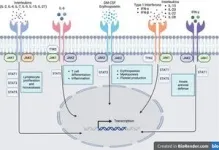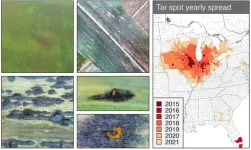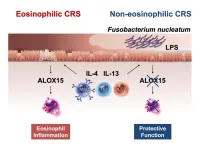(Press-News.org) LAWRENCE — The story of Ekgmowechashala, the final primate to inhabit North America before Homo sapiens or Clovis people, reads like a spaghetti western: A grizzled and mysterious loner, against the odds, ekes out an existence on the American Plains.
Except this tale unfolded about 30 million years ago, just after the Eocene-Oligocene transition during which North America saw great cooling and drying, making the continent less hospitable to warmth-loving primates.
Today, paleontologists from the University of Kansas and the Institute of Vertebrate Paleontology and Paleoanthropology in Beijing have published evidence in the Journal of Human Evolution shedding light on the long-standing saga of Ekgmowechashala, based on fossil teeth and jaws found in both Nebraska and China.
To do so, the researchers first had to reconstruct its family tree, a job helped by the discovery of an even more ancient Chinese “sister taxon” of Ekgmowechashala the team has named Palaeohodites (or “ancient wanderer”). The Chinese fossil discovery resolves the mystery of Ekgmowechashala’s presence in North America, showing it was an immigrant rather than the product of local evolution.
“This project focuses on a very distinctive fossil primate known to paleontologists since the 1960s,” said lead author Kathleen Rust, a doctoral candidate in paleontology at KU’s Biodiversity Institute and Natural History Museum. “Due to its unique morphology and its representation only by dental remains, its place on the mammalian evolutionary tree has been a subject of contention and debate. There’s been a prevailing consensus leaning towards its classification as a primate. But the timing and appearance of this primate in the North American fossil record are quite unusual. It appears suddenly in the fossil record of the Great Plains more than 4 million years after the extinction of all other North American primates, which occurred around 34 million years ago.”
In the 1990s, Rust’s doctoral adviser and co-author Chris Beard, KU Foundation Distinguished Professor and senior curator of vertebrate paleontology, collected fossils from the Nadu Formation in the Baise Basin in Guangxi, China, that closely resembled the Ekgmowechashala material known from North America. By that time, Ekgmowechashala was notoriously enigmatic among North American paleontologists.
“When we were working there, we had absolutely no idea that we would find an animal that was closely related to this bizarre primate from North America, but literally as soon as I picked up the jaw and saw it, I thought, ‘Wow, this is it,’” Beard said. “It’s not like it took a long time, and we had to undertake all kinds of detailed analysis — we knew what it was. Here in KU’s collection, we have some critical fossils, including what is still by far the best upper molar of Ekgmowechashala known from North America. That upper molar is so distinctive and looks quite similar to the one from China that we found that it kind of seals the deal.”
Beard left it to Rust to conduct the morphological analysis that tied Ekgmowechashala and its cousin Palaeohodites from China in a phylogenetic tree to establish their evolutionary relationships.
In the course of the work, Rust was able to draw conclusions about how Ekgmowechashala came to be discovered in Nebraska, millions of years after its fellow primates died out in the continent’s fossil record.
“We collected a substantial amount of morphological data to create an evolutionary tree using a phylogenetic reconstruction software and algorithm,” Rust said. “This evolutionary tree suggests a close evolutionary relationship between North American Ekgmowechashala and Palaeohodites from China, which Chris and his colleagues discovered in the 1990s. The results from our analysis unequivocally supports this hypothesis.”
The KU researchers said their discovery is not only exciting in terms of discovering a new primate species from late Eocene China — but also in settling the origin story of Ekgmowechashala. Based on their investigation, Ekgmowechashala did not descend from an older North American primate that somehow survived the cooler and drier conditions that caused other North American primates to go extinct. Rather, its ancestors crossed over the Beringian region millions of years later, anticipating the route followed by the first Native Americans much later in time.
“Our analysis dispels the idea that Ekgmowechashala is a relic or survivor of earlier primates in North America,” Rust said. “Instead, it was an immigrant species that evolved in Asia and migrated to North America during a surprisingly cool period, most likely via Beringia.”
Species like Ekgmowechashala that show up suddenly in the fossil record long after their relatives have died off are referred to as “Lazarus taxa” after the biblical figure who was raised from the dead.
“The ‘Lazarus effect’ in paleontology is when we find evidence in the fossil record of animals apparently going extinct — only to reappear after a long hiatus, seemingly out of nowhere,” Beard said. “This is the grand pattern of evolution that we see in the fossil record of North American primates. The first primates came to North America about 56 million years ago at the beginning of the Eocene, and they flourished on this continent for more than 20 million years. But they went extinct when climate became cooler and drier near the Eocene-Oligocene boundary, about 34 million years ago. Several million years later Ekgmowechashala shows up like a drifting gunslinger in a Western movie, only to be a flash in the pan as far as the long trajectory of evolution is concerned. After Ekgmowechashala is gone for more than 25 million years, Clovis people come to North America, marking the third chapter of primates on this continent. Like Ekgmowechashala, humans in North America are a prime example of the Lazarus effect.”
Rust and Beard were joined in the work by co-authors Xijun Ni of the Chinese Academy of Sciences, Beijing, and Kristen Tietjen, scientific illustrator with the KU Biodiversity Institute and Natural History Museum.
According to Rust, the tale of Ekgmowechashala is worth people’s attention because it happened in an era of profound environmental and climatic changes, much like our own that’s driven by human activity.
“It’s crucial to comprehend how past biota reacted to such shifts,” she said. “In such situations, organisms typically either adapt by retreating to more hospitable regions with available resources or face extinction. Around 34 million years ago, all of the primates in North America couldn’t adapt and survive. North America lacked the necessary conditions for survival. This underscores the significance of accessible resources for our non-human primate relatives during times of drastic climatic change.”
The study is also a part of a larger story that represents the earliest chapters of our own evolutionary journey that ultimately led to our own species, Rust said.
“Understanding this narrative is not only humbling, but also helps us appreciate the depth and complexity of the dynamic planet we inhabit,” she said. “It allows us to grasp the intricate workings of nature, the power of evolution in giving rise to life and the influence of environmental factors.”
END
Fossils tell tale of last primate to inhabit North America before humans
2023-11-06
ELSE PRESS RELEASES FROM THIS DATE:
It’s corn! It has the…spots? Researchers supply significant genomic insight into tar spot of corn
2023-11-06
First reported in 2015, tar spot is an emerging disease on corn that has rapidly spread across the United States and Canada, causing tremendous yield loss estimated at $1.2 billion in 2021 alone. Tar spot gets its name from its iconic symptoms that resemble the splatter of “tar” on corn leaves, but these spots are in fact brown lesions formed by the fungal pathogen Phyllachora maydis. This destructive pathogen is challenging to research because it cannot survive outside its plant host; therefore, little information is currently known about the mechanisms that contribute to its disease cycle including spore formation, reproduction, and plant ...
Incheon National University scientists develop new hydrogels for wound management
2023-11-06
Open wounds, whether caused by accidents or from medical procedures like surgery, require proper management to speed up healing and prevent infections. While sutures and staples are common wound closure methods, they can cause secondary tissue injuries, potentially leaking fluids and gases and requiring anesthetics. Tissue adhesive glues are a more attractive alternative but often suffer from toxicity and weak adhesion.
Fortunately, tissue adhesive patches offer an innovative solution. They allow precise control of adhesion and mechanical properties through adjustable polymeric compositions. These patches can also deliver ...
Nasal microorganism to the rescue? Study confirms protective role of bacterium in chronic rhinosinusitis
2023-11-06
Like other countries in the world, Japan has witnessed a worrisome increase in the prevalence of chronic rhinosinusitis (CRS) over the last decade. An inflammatory disease that lasts at least 12 weeks, CRS can cause nasal congestion, nasal discharge, trouble breathing through the nose, facial pain, and even loss of sense of smell. Unfortunately, treating CRS is complex since the disease manifests in various forms. CRS can be categorized into eosinophilic (ECRS) or non-eosinophilic (non-ECRS) types. In ECRS, the nasal and sinus tissues exhibit an increased presence of eosinophils, a type of white blood cell that releases inflammatory ...
American Indian and Alaska Native adults had higher rate of premature heart attack deaths
2023-11-06
Research Highlights:
American Indian and Alaska Native adults had significantly higher death rates from premature heart attacks compared to white, Black and Asian/Pacific Islander adults in the U.S., according to an analysis of more than 370,000 heart attack deaths from 1999-2020.
In addition, despite an overall decrease in heart attack death rates among American Indian and Alaska Native adults during the last two decades, heart attack-related deaths in American Indian and Alaska Native adult men younger than 55 years old and women younger than 65 years old did not decrease.
Embargoed until 4 a.m. CT/5 a.m. ...
A child’s race, ethnicity and/or neighborhood may influence survival after cardiac arrest
2023-11-06
Research Highlights:
A child’s race, ethnicity and/or the neighborhood where they live may have an impact on their survival and recovery after a cardiac arrest.
Black children were more than four times more likely to experience a cardiac arrest compared to white or Hispanic children.
Children from neighborhoods with the highest socioeconomic status had the best odds of surviving and functioning well after a cardiac arrest.
Embargoed until 4 a.m. CT/5 a.m. ET, Monday, Nov. 6, 2023
DALLAS, Nov. 6, 2023 — Children’s ...
Marijuana use linked with increased risk of heart attack, heart failure
2023-11-06
Research Highlights:
As more people across the U.S. use marijuana for medical and recreational reasons, two new studies suggest its regular intake may damage heart and brain health.
In one study, daily use of marijuana raised the risk of developing heart failure by about one-third, even after considering other factors, compared to people who reported never using marijuana.
In a second study, older people with any combination of Type 2 diabetes, high blood pressure and high cholesterol who used marijuana, ...
Transgender adults in rural US had disproportionately higher cardiovascular disease risk
2023-11-06
Research Highlights:
In a small study of adults living in rural America, those who identified as transgender were more likely to have cardiovascular disease risk factors, including tobacco use, obesity, high blood pressure, Type 2 diabetes or insulin resistance, high cholesterol and/or alcohol use.
Study participants with the highest odds of having cardiovascular disease risk factors were transgender males.
The findings highlight the need for interventions focused on reducing health disparities among the transgender population, researchers said.
Embargoed until 4 a.m. CT/5 a.m. ET, Monday, Nov. 6, 2023
DALLAS, Nov. 6, 2023 — Transgender ...
Experimental pacemaker converts heartbeat energy to recharge battery
2023-11-06
Research Highlights:
An experimental, leadless pacemaker housing is able to partially recharge the device’s battery by generating electrical energy from heartbeats.
The device generated about 10% of the energy needed to stimulate another heartbeat.
The preliminary findings show that leadless pacemaker batteries may be recharged by converting the heart’s mechanical/pressure energy into electrical energy, however, more research is needed.
Embargoed until 4 a.m. CT/5 a.m. ET, Monday, Nov. 6, 2023
DALLAS, ...
Menstrual cycle disorders may be linked to increased cardiovascular disease risk in women
2023-11-06
Research Highlights:
High blood pressure risk was higher among adolescent girls with a condition associated with irregular menstrual periods called polycystic ovary syndrome, compared to teens without this condition, according to a study of girls between 13-17 years of age.
In a separate study of women younger than age 50, those with painful menstrual periods had a notably higher risk of heart disease compared with those women without the condition known as dysmenorrhea.
Researchers of both studies suggest future investigations focus on how these reproductive conditions may impact women’s long-term cardiovascular disease risk.
Embargoed until 4 a.m. CT/5 a.m. ET, Monday, Nov. ...
AI may accurately detect heart valve disease and predict cardiovascular risk
2023-11-06
Research Highlights:
Artificial intelligence (AI) and deep learning models may help to predict the risk of cardiovascular disease events and detect heart valvular disease, according to two preliminary research studies.
One study found that artificial intelligence analyzing sound data of the heart recorded from a digital stethoscope was able to more accurately detect heart valve disease than a health care professional who listened to the heart with a traditional stethoscope.
In a study evaluating data from the UK Biobank, an artificial intelligence/deep learning program effectively analyzed and sorted eye images ...




